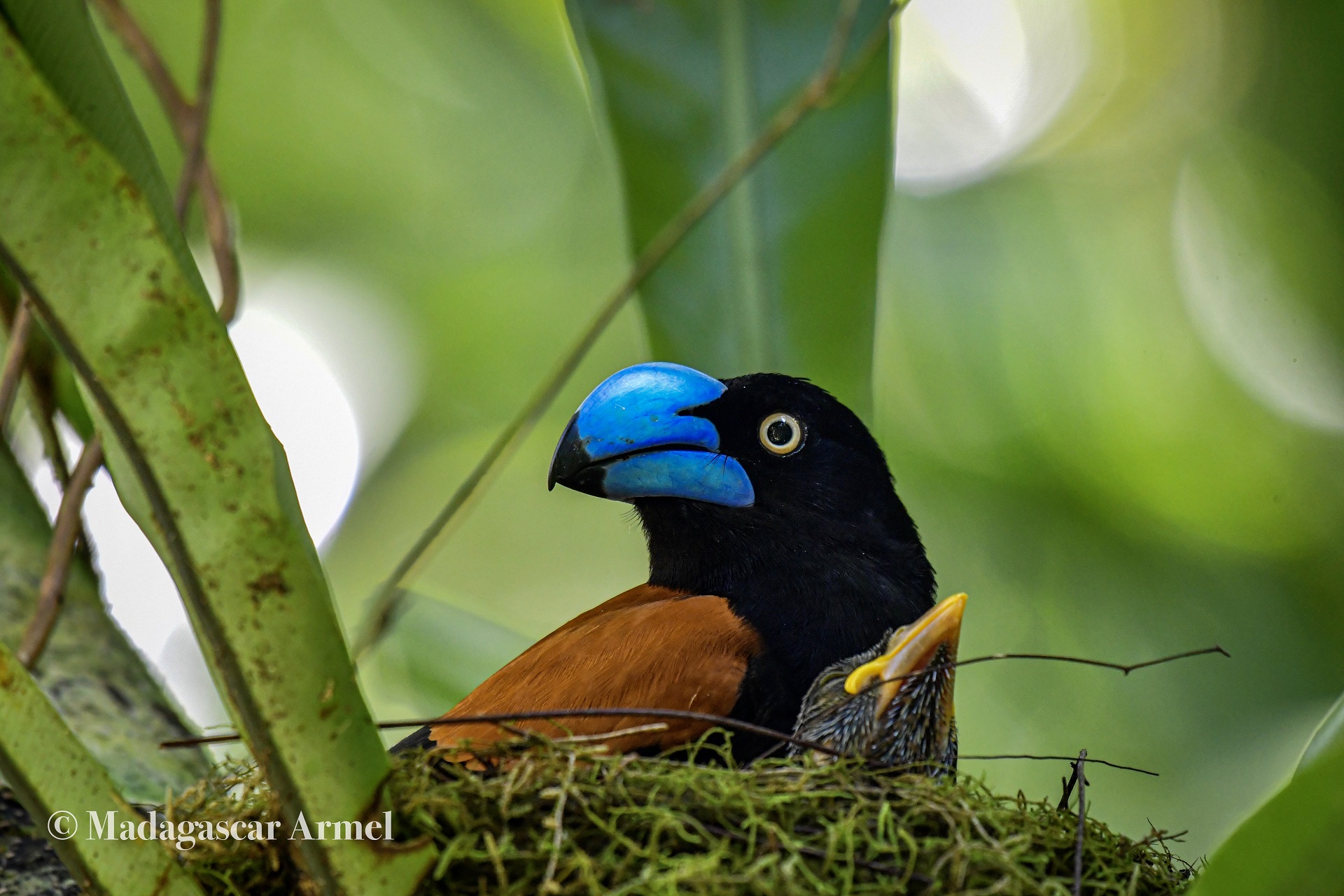
Birdwatching tour
This birding tour leads you to amazing rainforests and marshes, deciduous and spiny forests, which are no more a secret for you. The best time to see birds in Madagascar is during the breeding season from September to January.
- – The eastern evergreen humid forest allows seeing Pitta-like and Scaly Ground Rollers, Red-fronted and Blue Couas, Chabert’s and White-headed Vangas, Scops Owl and Collared Nightjars, the most spectacular and rare Helmet Vanga
- – In the western dry deciduous forest, we meet Van Dam’s Vanga, Schlegel’s Asity, White-breasted Mesite, Madagascar Crested Ibis.
- – The boundary zone between western and southern vegetation domain is home to Appert’s Greenbul, Sickle billed Vanga, and Giant Coua, Cuckoo Roller and White-browed Owl.
- – The southern deciduous dry forest holds Sub desert Mesite and Long-tailed Ground Roller, Verreaux’s Coua.
- – In the last vestiges of the highland you can find France’s Sparrowhawk, Malachite Kingfisher, Madagascar White Eye Madagascar Red Fody and Malagasy Pond Heron.
Many other animals like lemurs, chameleons, frogs and snakes can also be found during this tour.
Day 1: Arrival in Antananarivo
Arrival in Antananarivo, the capital of Madagascar.
The first birding spot is at Alarobia Tsarasaotra Lake which has Madagascar Pond Heron, Great and Dimorphic Egrets and Green-backed Herons. Large numbers of wildfowl occur and include White-faced and Fulvous Whistling Ducks, Red-billed and Hottentots’ Teal and Knob-billed Duck. In the reeds you may locate Malachite Kingfisher and singing Madagascar Swamp Warblers. Tall trees around the lake attract Madagascar Kestrel, Frances’s Sparrowhawk, Madagascar Wagtail, Madagascar White eye, Madagascar Fody and Madagascar Manikin. Night in a hotel.
Days 2-3: Antananarivo – Majunga / Ampijoroa Forest
Morning flight to Majunga and transfer to Ampijoroa forest station (115 Km from Majunga / 2h30) which is famous for its endemic mammals, birds, and other wildlife. En route we check rice fields at Amboromalandy Barrage Lake for Glossy Ibis, Black Egret, Black-winged Stilt, Purple and the uncommon Humblot’s Heron.
Upon our arrival in Ampijoroa, birds around the camp include Madagascar Bee-eater, Broad-billed Roller, Madagascar Hoopoe, Crested Drongo and Sakalava Weaver. Early mornings give us our best chance of locating White-breasted Mesite and the rare Schlegel’s Asity. Other key endemic species we hope to see Madagascar Crested Ibis, Madagascar Buttonquail, Madagascar Turtle Dove, Madagascar Green Pigeon, Grey-headed Lovebird, Coquerel’s and Red capped Couas, Madagascar Pygmy Kingfisher, Sickle-billed, Hook-billed, White-headed, Van Dam’s, Chabert’s and Red-tailed Vangas. Cuckoo Roller is often seen calling and displaying above the forest. The park vicinity is home to eight species of lemur. We should see the ‘dancing lemur’ – Coquerel’s Sifaka, Common Brown Lemur, and with luck, the rare and endangered Mongoose Lemur.
During an organized night walk, we may find Western Woolly Lemur, Fat-tailed Dwarf and Golden-brown Mouse Lemur.
Day 4: Ampijoroa Forest – Majunga
A visit to Ravelobe Lake which is home to Madagascar Fish Eagle whilst Madagascar Jacana and Allen’s Gallinule are numerous on the water lilies.
Return to Majunga where we spend the night.
Day 5: Majunga – Bombetoka Bay – Kinkony Lake
Morning boat trip to Bombetoka Bay where we explore the wetlands, mangrove forest and mudflats of the Betsiboka River. We should see the endemic Madagascar White Ibis, Madagascar Teal, Lesser and Greater Flamingos and possibly Madagascar Plover.
After lunch, we embark on a camping safari to Kinkony Lake, the second largest on the island.
Day 6: Kinkony Lake
Today we explore the lake in search of the very rare Sakalava Rail (in one of the few accessible areas) which was only rediscovered in 2002. In the reed beds we may observe Little Bittern, Purple Swamphen, Allen’s Gallinule, and Common Moorhen.
Day 7: Kinkony Lake – Majunga
On the way back towards Mitsinjo, we might have an opportunity to see a group of Decken’s and, with luck, Crowned Sifaka in remnant patches of the dry forest.
Night in Majunga.
Day 8: Majunga – Antananarivo
Fly back to Antananarivo.
On arrival in the capital we stay at Tamboho Hotel, a comfortable lodge where a marsh offers great birding opportunities for ducks, egrets and herons.
Days 9-10: Antananarivo – Andasibe National Park
Today leave the capital to reach Andasibe (145 Km / 3h) after a stop at the Mangoro River looking for the rock-loving Madagascar Pratincole.
There are two protected areas in Andasibe – Mantadia National Park and Analamazaotra Special Reserve. During your stay you should see Pitta-like, Rufous-headed, Scaly and Short-legged Ground Rollers as well as the secretive Red-breasted and Red-fronted Couas. In the understory you may find Blue Coua, Dark Newtonia, Velvet Asity, Spectacled Greenbul and Nelicourvi Weaver. Madagascar Blue Pigeon, Common Newtonia, Wedge-tailed Jery, Red-tailed, Blue, White-headed, Chabert’s, Nuthatch and sometimes Pollen’s Vanga and Ashy Cuckoo shrike prefer the forest canopy. An isolated lake within the park holds Madagascar Grebe and occasionally Meller’s Duck.
A visit to Torotorofotsy marsh in the south-west of Andasibe gives an opportunity of seeing Madagascar Rail and sometimes Madagascar and Slender-billed Flufftail. Andasibe is the best place to watch endemic Madagascar Long-eared and Madagascar Scops Owls and Collared Nightjar.
During your night walk in the Andasibe forest, you might see Goodman’s Mouse Lemur, the smallest primate in the world, and with luck, Furry-eared Dwarf Lemur and Mossy Leaf-tailed Gecko. Additionally, six diurnal lemurs occur in the protected area: Indri Indri (the largest lemur), Diademed Sifaka, Black-and-white Ruffed, Common Brown, Red-bellied and Eastern Grey Bamboo Lemurs.
Day 11: Andasibe – Antsirabe
An early morning visit to Eulophiella private forest for the extremely rare Helmet Vanga at one of its few known nesting sites.
Afterwards, you leave Andasibe for Antsirabe (315Km/6h30), stopping en route for Hamerkop, Squacco Heron and other wetland birds.
Day 12-13-14: Antsirabe – Ranomafana National Park
Today, you continue south to Ranomafana (239 Km/5h) where you stay for three nights.
This mountain rainforest area covers up to 42,000 hectares of land with waterfalls and rapids. At least, 12 lemur species live here including Golden Bamboo Lemur which was only discovered in 1986. Ranomafana Park is also famous for its avifauna – Pitta-like Ground Roller, Velvet Asity, White-throated Oxylabes, Crossley’s Babbler, and Rand’s Warblers. You also look for the secretive and terrestrial Madagascar Wood Rail, Brown Mesite, and if you are really lucky, Henst’s Goshawk. Species occurring at higher elevations comprise Yellow-bellied Sunbird Asity, Grey-crowned Greenbul and Brown Emutail.
Day 15: Ranomafana – Vohiparara – Ranohira
Leave Ranomafana after an early morning visit to Vohiparara mountain forest. You might see Madagascar Yellow-browed Oxylabes, Cryptic Warbler, Rufous-headed Ground Roller, and Pollen’s Vanga.
Drive to Ranohira ( 366 Km/7h ) where you stay overnight in a comfortable lodge.
Day 15: Ranohira – Zombitse – Ranohira
Leave the lodge for an early morning drive to Zombitse-Vohibasia Park (96 Km/2h), a remnant transitional dry deciduous forest. Zombitsy forest is home to Appert’s Greenbul which is limited in this area, Giant Coua, Lesser and Greater Vasa Parrots, Madagascar Flycatcher, Sickle billed, Hook-billed and Rufous Vangas and the diurnal Ring-tailed Lemur and Verreaux’s Sifaka. After lunch, you revisit the park for the impressive White-browed Owl.
Drive back to Ranohira where you’ll spend the night.
Day 16: Isalo National Park – Ifaty
A visit to Isalo NP, where a wetland has Hottentots’ and Red-billed Teal, White-backed Duck and Three-banded Plover. Along the trails of the Namaza Canyon and savannah habitats you may find Benson’s Rock Thrush, Madagascar Coucal and Madagascar Partridge. Birds of prey also feature, with opportunities of watching Sooty and Peregrine Falcons, Madagascar Harrier-Hawk and Madagascar Buzzard.
After lunch you leave for Ifaty (268 Km/5h30) where a night walk is planned for Torotoraka Scops Owl, Madagascar Nightjar, and with luck, Grey Brown Mouse Lemur.
Day 17: Ifaty / Reniala private reserve – Tulear
Today visit Ifaty Reniala for two localised endemics: Long-tailed Ground Roller and the arboreal Sub desert Mesite. Other species you may encounter include Madagascar Cuckoo-Hawk, Banded Kestrel, Running Coua, Thinornis Warbler, Archbold’s Newtonia and Subdesert Brush Warbler. Afternoon transfer to Tulear (25 Km/1h), where you spend the night.
Day 18: Tulear / Saint Augustin – Antananarivo
Early morning visit to Saint Augustin for Verreaux’s Coua and Red-shouldered Vanga, the latter being described in 1996.
After this visit, return to Tulear to look for shorebirds on the mudflats and salt meadows.
In the afternoon, you catch your domestic flight to Antananarivo for your last night in Madagascar.
Day 19 : Antananarivo – Fly OUT
Transfer to Ivato international airport for your international return flight.
Ask for a quote. According to your budget but also to the expected length of your stay, we can adjust the program and will consider accommodations that are adapted to your needs.

